Month: October 2023
‘Herstory’ walking tour highlights historic lesbian sites in the Village
October 16, 2023
By: Dashiell Allen
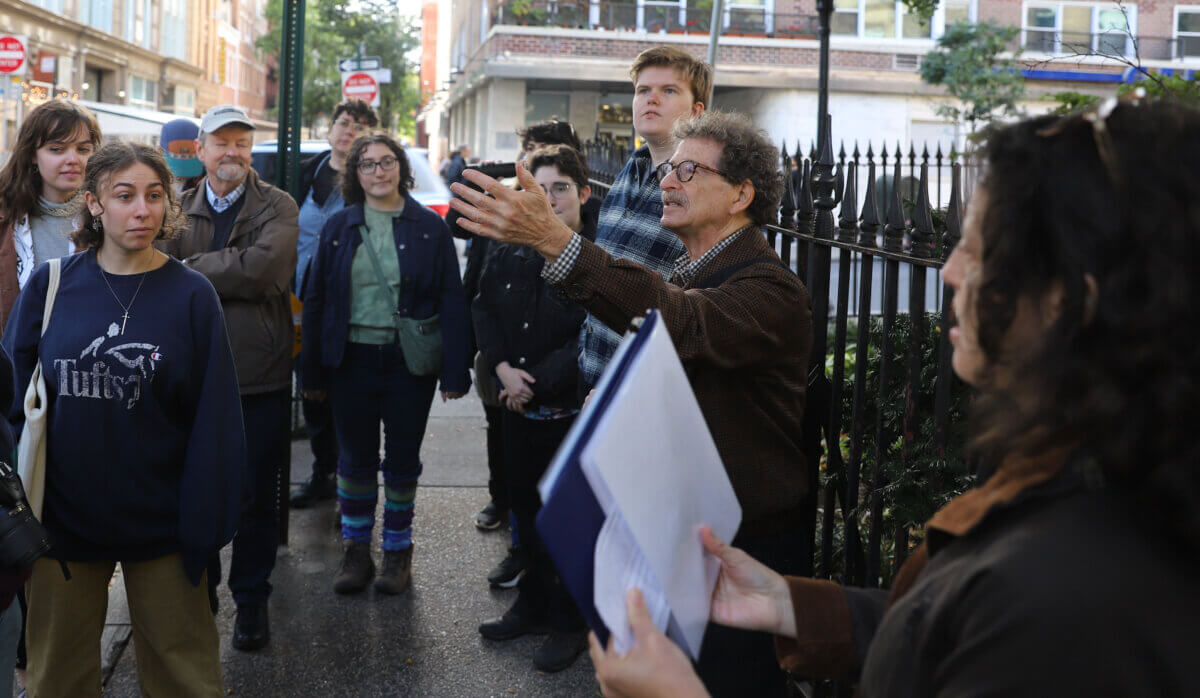
DASHIELL ALLEN
The part of Seventh Avenue South where West Fourth Street meets Christopher and Grove Streets is one of the busiest corridors in the West Village. Trendy restaurants and gay bars line the tourist-filled sidewalks and neighboring side streets, while heavy traffic rumbles by on its way to the Holland Tunnel to New Jersey. Unbeknownst to most passersby, however, the southeast corner of Grove and Seventh Avenue South — now home to the trendy pizza chain Two Boots — was, from 1972 to 1982, the Duchess, one of the city’s most popular lesbian bars at the time.
“It’s one of the most beloved sites that we’ve documented on our website from women who remember it,” said Amanda Davis, an architectural historian and project manager at the NYC LGBT Historic Sites Project, a non-profit dedicated to preserving and memorializing LGBTQ history throughout the city, with an ever-expanding interactive map of over 450 notable places.
The Duchess was popular with lesbian activists, Davis said. Among its patrons were lesbian cartoonist and writer Alison Bechdel, who recalled in 2016, “You’d step past the bouncer at the Duchess, and you were home free …. it afforded me the space to just be, with my guard down, and that was salvational.”
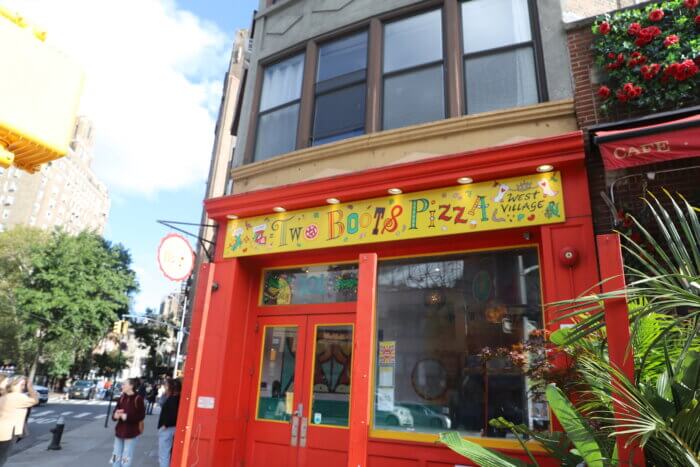
DASHIELL ALLEN
The Duchess, which had its liquor license revoked for refusing to serve men, was one of more than a dozen hidden-in-plain-site historic gems on the LGBT Historic Sites Project’s walking tour, the “Lesbian Herstory of the West Village,” on Sunday, Oct. 15. The tour took place during LGBTQ history month, which was founded in 1994 by Rodney Wilson, a gay Missouri high school teacher.
“It’s a nice time to bring people’s awareness to our project, as with Pride Month,” Davis said.
The tour started at the northwest corner of Washington Square Park, across the street from Eleanor Roosevelt’s 15th-floor residence in the 1940s. It was in that apartment that the former first lady invited many lesbian couples into her social circle and started her affair with the journalist Lorena Hickok, said Andrew Dolkart, a historian and project director with the LGBT Historic Sites Project.
From the park, the tour visited the former home of Lorraine Hansberry on Waverly Place. The playwright, most famous for her work “A Raisin In The Sun,” was a closeted lesbian, Davis said, and died at 34 of pancreatic cancer.
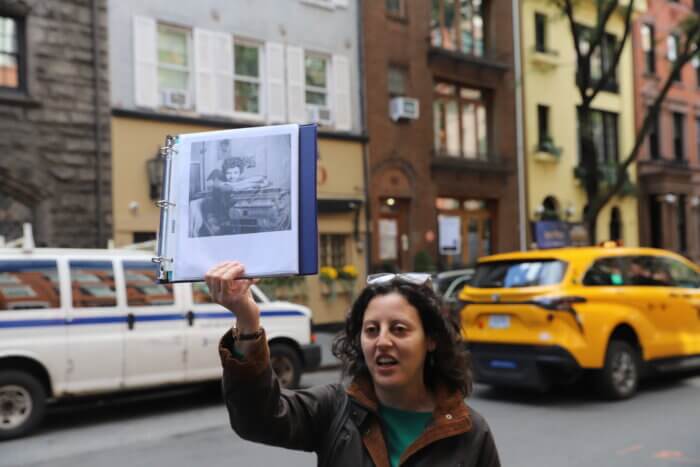
DASHIELL ALLEN
“Who’s to say if she would have been more comfortable over the years to come out,” Davis said. “But we do have letters from her,” and know she anonymously wrote “lesbian-themed short stories that appeared in popular gay and lesbian magazines of the time.”
The tour also stopped by 135 and 133 West Fourth Street, where, starting in 1972, under out gay minister Paul Ables, the former Washington Square United Methodist Church and Parish House provided a meeting place for the Salsa Soul Sisters, the “oldest Black lesbian organization in America,” according to the NYC LGBT Historic Sites Project. The organization still exists today under the name African Ancestral Lesbians United for Societal Change.
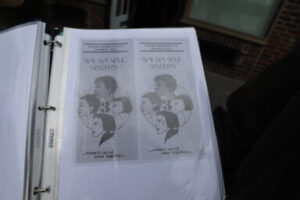
DASHIELL ALLEN
Back on the unsuspecting corner of Seventh Avenue South and Barrow Street is the former home of Labrys, New York City’s first feminist bookstore, opened by lesbian activists Marizel Rios and Jane Lurie in 1972. That’s where the phrase “The Future is Female” was coined.
“We had someone reach out to us about a year or two ago and she described Seventh Aavenue South as the lesbian super highway, because there were so many lesbian spaces,” Davis said. A few blocks down was also the Women’s Coffeehouse, from 1974 to 1978.
The LGBT Historic Sites Project has collected documents including pamphlets and flyers from many of the organizations spotlighted on the tour.
“There’s so much rich ephemeral stuff,” Dolkart said. “So think really carefully when you’re throwing things out or when you’re looking through your grandparent’s files and what they have that looks like it’s trash but is really, really valuable.” He said people can contribute documents they think might have historic value to places like the New York Public Library and New-York Historical Society.
The herstory walking tour concluded outside the now-open bar Henrietta Hudson — which describes itself as “a queer human bar built by dykes” — on Hudson Street. The space was formerly occupied, however, from 1983 to 1990, by Cubby Hole — not to be confused with the current-day Cubbyhole, another lesbian bar on West 12th Street.
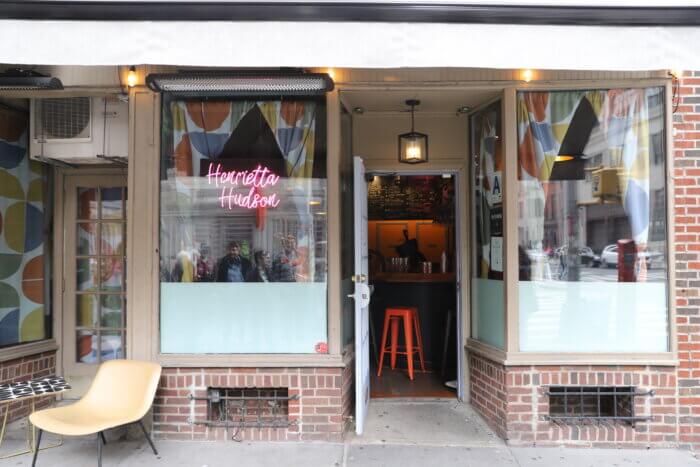
DASHIELL ALLEN
At the intersection of the past and present, the two bars are a testament to the LGBTQ community’s ever-growing New York City history. While the NYC LGBT Historic Sites Project currently researches sites that existed pre-2000, Dolkart acknowledged that may some day change.
“History becomes faster and faster,” he said. “At some point we’re going to have to rethink that I think and look at more recent sites.”
In the past year the project added over 25 sites to their map, Davis said, with many more in the pipeline, including the homes of several children’s book authors. The project is also in the process of completing an overlay of historic LGBTQ sites in the West Village to be added to the National Registry of Historic Sites.
Making New York City’s LGBT Historic Sites Visible
October 2, 2023
By: New York Road Runners
New York City is home to hundreds of sites connected to lesbian, gay, bisexual, and transgender history. The NYC LGBT Historic Sites Project is a cultural heritage initiative that documents and presents the often untold stories of these sites.
In June, as part of our celebration of Pride Month, NYRR staff members went on a walking tour of important LGBT historic sites in Manhattan’s West Village with NYC LGBT Historic Sites Project guide Amanda Davis.
Check out the highlights as we celebrate LGBT History Month this October! For more information about NYC LGBT Historic Sites Project including tours all over the NYC–metro area, visit their website.
New York City AIDS Memorial St. Vincent’s Triangle
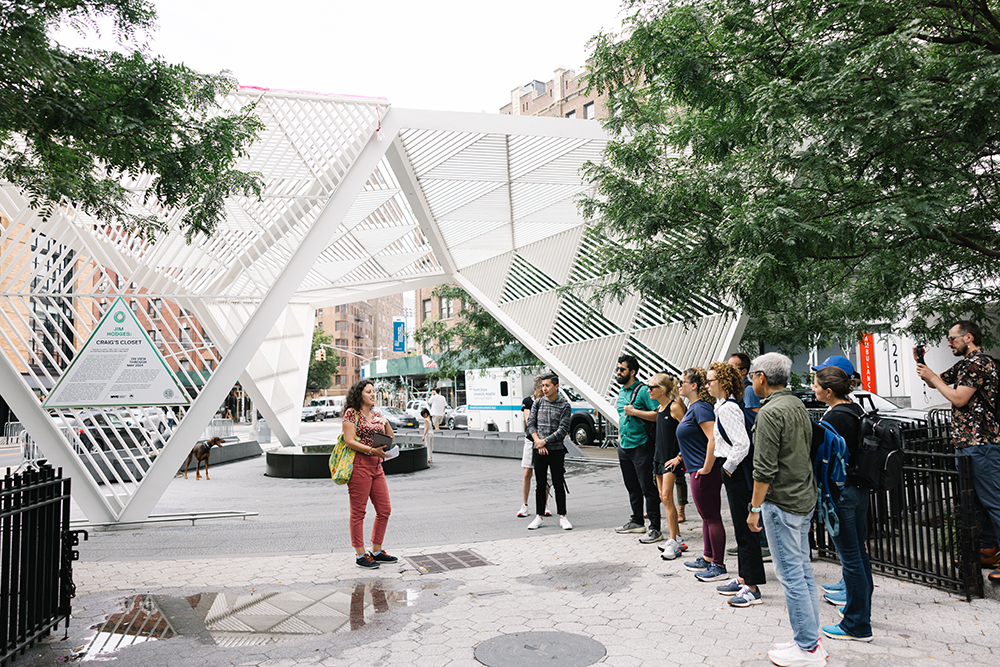
Dedicated in 2016, this memorial honors the more than 100,000 New Yorkers who have died of AIDS since the early 1980s and recognizes the contributions of caregivers and activists, many of whom were affiliated with the nearby former St. Vincent’s Hospital. The hospital, demolished in 2013, was “ground zero” of the AIDS epidemic in NYC and housed the largest AIDS ward on the East coast.
Washington Square United Methodist Church & Parish House
135-133 West 4th Street
This church was known for its progressive stance, including its acceptance of the LGBT community; the congregation was led by the pioneering openly gay Reverend Paul M. Abels from 1973 to 1984. The church and parish house provided meeting space for LGBT groups including the Salsa Soul Sisters—the oldest Black lesbian organization in the U.S.—from 1976 to 1987.
Caffe Cino
31 Cornelia Street
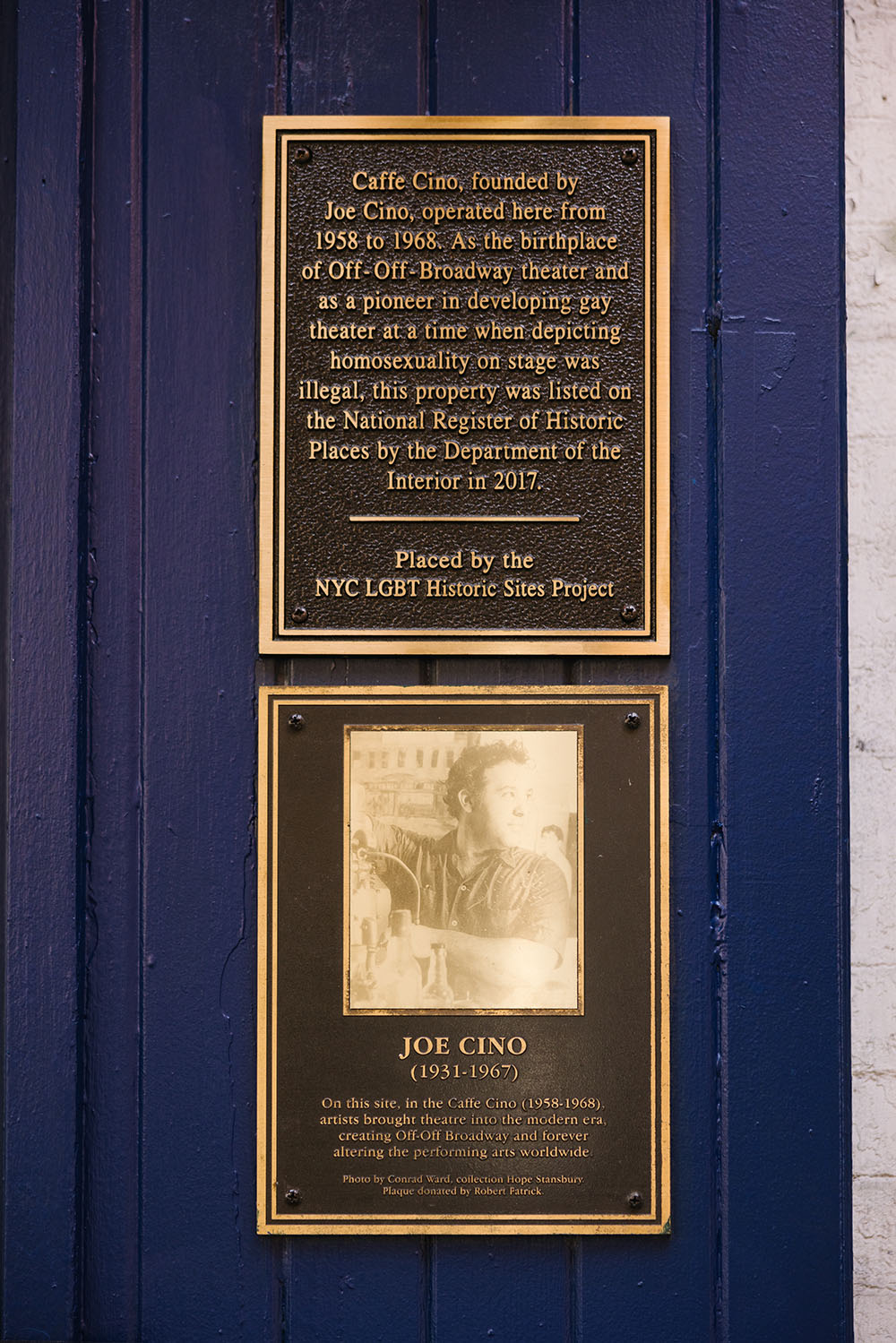
Widely recognized as the birthplace of Off-Off-Broadway theater, the Caffe Cino was located on the ground floor of this building from 1958 to 1968. It was significant in the development of gay theater at a time when it was illegal to depict homosexuality on stage.
Oscar Wilde Memorial Bookshop
15 Christopher Street
The first gay and lesbian bookstore on the East coast, this bookshop moved in 1973 from its original home on Mercer Street to its more prominent location near the center of NYC’s gay life. Also serving as a community center, it remained here for 35 years.
Stonewall Inn
51-53 Christopher Street
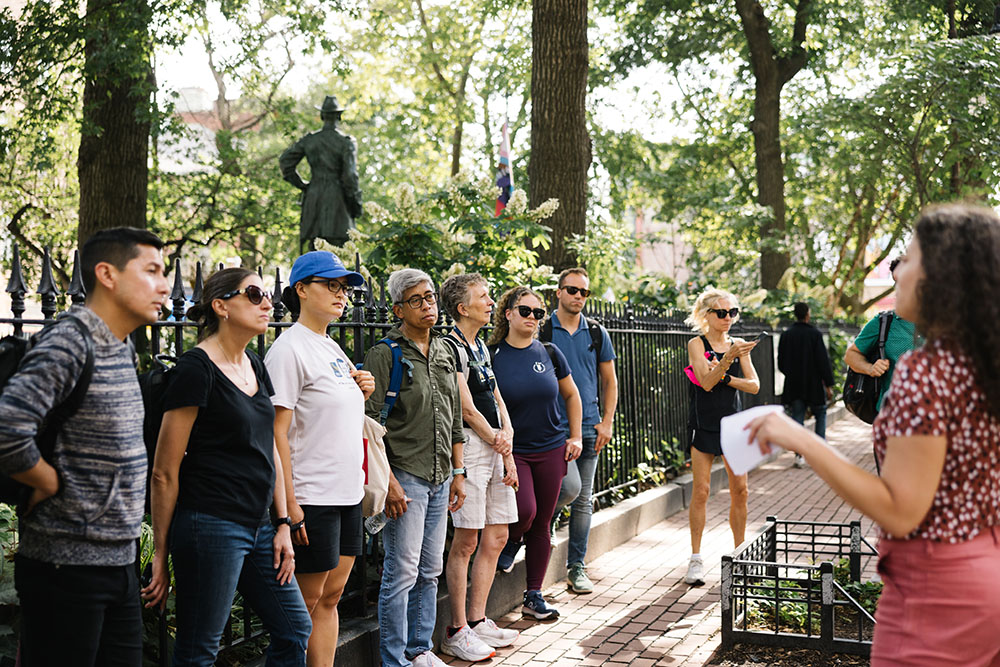
From June 28 to July 3, 1969, LGBT patrons of the Stonewall Inn and members of the local community took the unusual action of fighting back during a routine police raid at the bar. These events are seen as a key turning point and a catalyst for explosive growth in the gay rights movement that began in the United States in 1950 with the founding of the Mattachine Society in Los Angeles. In the immediate aftermath, large numbers of groups formed around the country.
Stonewall became the first LGBT site in the country to be listed on the National Register of Historic Places (1999) and named a National Historic Landmark (2000).
Read the original story at the New York Road Runners blog here.